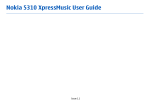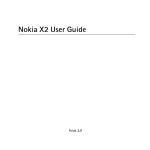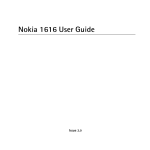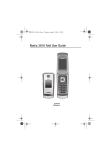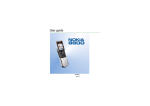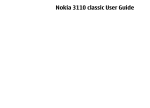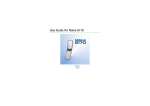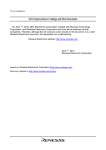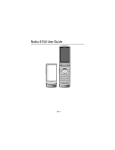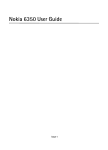Download Nokia 6750 User Guide
Transcript
Nokia 6750 User Guide Issue 1 ENU 0434 DECLARATION OF CONFORMITY Hereby, NOKIA CORPORATION declares that this RM-381 product is in compliance with the essential requirements and other relevant provisions of Directive 1999/5/EC. A copy of the Declaration of Conformity can be found at www.nokia.com/phones/declaration_of_conformity/. © 2009 Nokia. All rights reserved. Inside pages contain 10% recycled paper. Nokia, Nokia Connecting People, and Navi are trademarks or registered trademarks of Nokia Corporation. Nokia tune is a sound mark of Nokia Corporation. Other product and company names mentioned herein may be trademarks or tradenames of their respective owners. Reproduction, transfer, distribution, or storage of part or all of the contents in this document in any form without the prior written permission of Nokia is prohibited. Nokia operates a policy of continuous development. Nokia reserves the right to make changes and improvements to any of the products described in this document without prior notice. US Patent No 5818437 and other pending patents. T9 text input software Copyright © 1997-2009. Tegic Communications, Inc. All rights reserved. Includes RSA BSAFE cryptographic or security protocol software from RSA Security. Java is a trademark of Sun Microsystems, Inc. Portions of the Nokia Maps software are © 1996-2009 The FreeType Project. All rights reserved. This product is licensed under the MPEG-4 Visual Patent Portfolio License (i) for personal and noncommercial use in connection with information which has been encoded in compliance with the MPEG-4 Visual Standard by a consumer engaged in a personal and noncommercial activity and (ii) for use in connection with MPEG-4 video provided by a licensed video provider. No license is granted or shall be implied for any other use. Additional information, including that related to promotional, internal, and commercial uses, may be obtained from MPEG LA, LLC. See http://www.mpegla.com. Nokia operates a policy of ongoing development. Nokia reserves the right to make changes and improvements to any of the products described in this document without prior notice. TO THE MAXIMUM EXTENT PERMITTED BY APPLICABLE LAW, UNDER NO CIRCUMSTANCES SHALL NOKIA OR ANY OF ITS LICENSORS BE RESPONSIBLE FOR ANY LOSS OF DATA OR INCOME OR ANY SPECIAL, INCIDENTAL, CONSEQUENTIAL OR INDIRECT DAMAGES HOWSOEVER CAUSED. THE CONTENTS OF THIS DOCUMENT ARE PROVIDED “AS IS”. EXCEPT AS REQUIRED BY APPLICABLE LAW, NO WARRANTIES OF ANY KIND, EITHER EXPRESS OR IMPLIED, INCLUDING, BUT NOT LIMITED TO, THE IMPLIED WARRANTIES OF MERCHANTABILITY AND FITNESS FOR A PARTICULAR PURPOSE, ARE MADE IN RELATION TO THE ACCURACY, RELIABILITY OR CONTENTS OF THIS DOCUMENT. NOKIA RESERVES THE RIGHT TO REVISE THIS DOCUMENT OR WITHDRAW IT AT ANY TIME WITHOUT PRIOR NOTICE. The availability of particular products and applications and services for these products may vary by region. Please check with your Nokia dealer for details, and availability of language options. The third-party applications provided with your device may have been created and may be owned by persons or entities not affiliated with or related to Nokia. Nokia does not own the copyrights or intellectual property rights to the third-party applications. As such, Nokia does not take any responsibility for end-user support, functionality of the applications, or the information in the applications or these materials. Nokia does not provide any warranty for the third-party applications. BY USING THE APPLICATIONS YOU ACKNOWLEDGE THAT THE APPLICATIONS ARE PROVIDED AS IS WITHOUT WARRANTY OF ANY KIND, EXPRESS OR IMPLIED, TO THE MAXIMUM EXTENT PERMITTED BY APPLICABLE LAW. YOU FURTHER ACKNOWLEDGE THAT NEITHER NOKIA NOR ITS AFFILIATES MAKE ANY REPRESENTATIONS OR WARRANTIES, EXPRESS OR IMPLIED, INCLUDING BUT NOT LIMITED TO WARRANTIES OF TITLE, MERCHANTABILITY OR FITNESS FOR A PARTICULAR PURPOSE, OR THAT THE APPLICATIONS WILL NOT INFRINGE ANY THIRD-PARTY PATENTS, COPYRIGHTS, TRADEMARKS, OR OTHER RIGHTS. Export controls This device may contain commodities, technology or software subject to export laws and regulations from the US and other countries. Diversion contrary to law is prohibited. FCC/INDUSTRY CANADA NOTICE Your device may cause TV or radio interference (for example, when using a telephone in close proximity to receiving equipment). The FCC or Industry Canada can require you to stop using your telephone if such interference cannot be eliminated. If you require assistance, contact your local service facility. This device complies with part 15 of the FCC rules. Operation is subject to the following two conditions: (1) This device may not cause harmful interference, and (2) this device must accept any interference received, including interference that may cause undesired operation. Any changes or modifications not expressly approved by Nokia could void the user's authority to operate this equipment. Issue 1 ENU Contents SAFETY.............................................. 6 About your device............................ 6 Network services............................................... 7 Shared memory ................................................. 8 Access codes ...................................................... 8 Configuration settings service ...................... 8 Accessories ......................................................... 9 Setting for telecoil hearing aid users.......... 9 Software updates.............................................. 9 Download content............................................ 9 Nokia support ................................................. 10 1. Get started.................................. 10 Insert SIM card and battery........................ Insert a microSD card................................... Charge the battery ........................................ Connect a headset......................................... Antenna............................................................ 10 12 12 13 13 2. Your phone ................................. 14 Keys and parts ................................................ Key functions .................................................. Standby mode................................................. Keypad lock (keyguard) ................................ Offline profile.................................................. Functions without a SIM card ................... 14 15 15 16 17 17 3. Call functions ............................. 18 Make a voice call........................................... 18 Answer or end a call ..................................... 19 Options during a voice call ......................... 19 4. Navigate the menus................... 20 5. Enter text.................................... 20 Service commands ......................................... 24 Delete messages ............................................. 24 Message settings............................................ 24 7. Contacts ..................................... 25 Find a contact ................................................. 25 Add a new contact......................................... 25 Copy contacts.................................................. 25 Edit contact details........................................ 26 Delete contacts or details............................ 26 Business cards................................................. 26 Settings ............................................................. 26 Groups ............................................................... 27 1-touch dialing list........................................ 27 8. Log .............................................. 27 9. Settings ...................................... 28 Set profiles ....................................................... 28 Set theme ......................................................... 28 Tones.................................................................. 28 Lights ................................................................. 28 Hidden cover display ..................................... 29 Main display .................................................... 29 Set time and date........................................... 29 My shortcuts.................................................... 30 Sync and backup ............................................ 30 Connectivity..................................................... 30 Call settings ..................................................... 32 Phone settings ................................................ 33 Accessories....................................................... 34 Configuration .................................................. 34 Security ............................................................. 35 Reset device..................................................... 35 Predictive text input ..................................... 20 Traditional text input ................................... 21 10. Gallery...................................... 36 6. Messaging................................... 21 11. Media ....................................... 36 Text and multimedia messages.................. Text messages................................................. Multimedia messages................................... SIM messages ................................................. Voice messages .............................................. 4 21 21 22 23 23 Format memory card..................................... 36 Camera .............................................................. 36 Media player.................................................... 38 Voice recorder ................................................. 39 Equalizer ........................................................... 40 12. Organizer.................................. 40 Alarm clock...................................................... Calendar ........................................................... To-do list.......................................................... Notes ................................................................. Calculator......................................................... Countdown timer........................................... Stopwatch........................................................ 40 41 41 42 42 42 43 13. Applications............................. 43 Play a game..................................................... 43 Open an application...................................... 43 Download an application ............................ 43 14. Web .......................................... 44 Configuration settings ................................. Connect to the web ...................................... Bookmarks ....................................................... Display settings .............................................. Security settings ............................................ 44 44 45 45 45 Cache memory ................................................ 46 Browser security............................................. 46 15. PC connectivity ....................... 46 Nokia PC Suite ................................................ 46 Packet data ...................................................... 47 Data communication applications ............ 47 16. Battery and charger information .................................... 47 Charging and discharging............................ 47 Nokia battery authentication guidelines ......................................................... 48 Taking care of your device............ 49 Additional safety information ...... 50 Index ............................................... 54 5 SAFETY Read these simple guidelines. Not following them may be dangerous or illegal. Read the complete user guide for further information. SWITCH ON SAFELY Do not switch the device on when wireless phone use is prohibited or when it may cause interference or danger. ROAD SAFETY COMES FIRST Obey all local laws. Always keep your hands free to operate the vehicle while driving. Your first consideration while driving should be road safety. INTERFERENCE All wireless devices may be susceptible to interference, which could affect performance. SWITCH OFF IN RESTRICTED AREAS Follow any restrictions. Switch the device off in aircraft, near medical equipment, fuel, chemicals, or blasting areas. QUALIFIED SERVICE Only qualified personnel may install or repair this product. ENHANCEMENTS AND BATTERIES Use only approved enhancements and batteries. Do not connect incompatible products. WATER-RESISTANCE Your device is not water-resistant. Keep it dry. About your device ■ The wireless device described in this guide is approved for use on the GSM 850, 900, 1800, and 1900; and UMTS 850,1900, and 2100 networks. Contact your service provider for more information about networks. When using the features in this device, obey all laws and respect local customs, privacy and legitimate rights of others, including copyrights. Copyright protection may prevent some images, music, and other content from being copied, modified, or transferred. Your device supports several methods of connectivity. Like computers, your device may be exposed to viruses and other harmful content. Exercise caution with 6 messages, connectivity requests, browsing, and downloads. Only install and use services and other software from trustworthy sources that offer adequate security and protection against harmful software, such as applications that are Symbian Signed or have passed the Java VerifiedTM testing. Consider installing antivirus and other security software on your device and any connected computer Your device may have preinstalled bookmarks and links for third-party internet sites. You may also access other third-party sites through your device. Third-party sites are not affiliated with Nokia, and Nokia does not endorse or assume liability for them. If you choose to access such sites, you should take precautions for security or content. Note: Your device can only support one antivirus application. Having more than one application with antivirus functionality could affect performance and operation or cause the device to stop functioning. Warning: To use any features in this device, other than the alarm clock, the device must be switched on. Do not switch the device on when wireless device use may cause interference or danger. When connecting to any other device, read its user guide for detailed safety instructions. Do not connect incompatible products. Make back-up copies or keep a written record of all important information stored in your device. Keep your device away from magnets or magnetic fields. ■ Network services To use the device you must have service from a wireless service provider. Some features are not available on all networks; other features may require that you make specific arrangements with your service provider to use them. Network services involve transmission of data. Check with your service provider for details about fees in your home network and when roaming in other networks. Your service provider can explain what charges will apply. Some networks may have limitations that affect how you can use some features of this device requiring network support such as support for specific technologies like WAP 2.0 protocols (HTTP and SSL) that run on TCP/IP protocols and language-dependent characters. Your service provider may have requested that certain features be disabled or not activated in your device. If so, these features will not appear on your device menu. Your device may also have customized items such as menu names, menu order, and icons. 7 ■ Shared memory The following features in this device may share memory: tones, graphics, contacts, text messages, multimedia, calendar, To-Do Notes, JavaTM games, applications, and the Notes application. Use of one or more of these features may reduce the memory available for the remaining features. If your device displays a message that the memory is full, delete some of the information or entries stored in the shared memory. ■ Access codes To set how your phone uses the access codes and security settings, select Menu > Settings > Security > Access codes. • The PIN (UPIN) code, supplied with the SIM (USIM) card, helps to protect the card against unauthorized use. The default code is 12345. • The PIN2 (UPIN2) code, supplied with some SIM (USIM) cards, is required to access certain services. • The personal unblocking key (PUK) code and the universal personal unblocking key (UPUK) code (8 digits) are required to change a blocked PIN code and UPIN code, respectively. The PUK2 code (8 digits) is required to change a blocked PIN2 code. These codes are not supplied with the SIM card. Contact your local service provider for the codes. If you enter the PIN code incorrectly three times in succession, you are asked for the PUK code. • The security code helps to protect your phone against unauthorized use. You can create and change the code, and set the phone to request the code. Keep the code secret and in a safe place separate from your phone. If you forget the code and your phone is locked, your phone will require service and additional charges may apply. For more information, contact a Nokia Care point or your phone dealer. • The call restriction password is required when using the call barring service to restrict calls to and from your phone (network service). • To view or change the security module settings for the web browser, select Menu > Settings > Security > Security module sett. ■ Configuration settings service To use some of the network services, such as mobile internet services, MMS, or remote internet server synchronization, your phone needs the correct configuration settings. For more information on availability, contact your service 8 provider, nearest authorized Nokia dealer, or visit the support area on the Nokia website, www.nokia.com/support. When you have received the settings as a configuration message, and the settings are not automatically saved and activated, Configuration settings received is displayed. ■ Accessories Warning: Use only batteries, chargers, and accessories approved by Nokia for use with this particular model. The use of any other types may invalidate any approval or warranty, and may be dangerous. In particular, use of unapproved chargers or batteries may present a risk of fire, explosion, leakage, or other hazard. For availability of approved accessories, please check with your dealer. When you disconnect the power cord of any accessory, grasp and pull the plug, not the cord. ■ Setting for telecoil hearing aid users This device includes a setting for direct connection to telecoil-equipped hearing aids. When both the telecoil hearing aid (T switch) and the phone telecoil are activated, using the device with the aided ear will provide a direct connection for audio through your hearing aid. The quality of sound depends on the type of hearing aid used. You should test the device with the telecoil setting activated to determine whether your audio performance improves. Using the telecoil hearingaid setting consumes additional battery power. ■ Software updates Nokia may produce software updates that may offer new features, enhanced functions, or improved performance. You may be able to request these updates through the Nokia Software Updater PC application. To update the device software, you need the Nokia Software Updater application and a compatible PC with Microsoft Windows 2000, XP, or Vista operating system, broadband internet access, and a compatible data cable to connect your device to the PC. To get more information and to download the Nokia Software Updater application, see www.nokia.com/softwareupdate or your local Nokia website. ■ Download content You may be able to download new content (for example, themes) to the phone (network service). For the availability of different services and pricing, contact your service provider. Important: Use only services that you trust and that offer adequate security and protection against harmful software. 9 ■ Nokia support Check www.nokia.com/support or your local Nokia website for the latest version of this guide, additional information, downloads, and services related to your Nokia product. On the website, you can get information on the use of Nokia products and services. If you need to contact customer service, check the list of local Nokia Care contact centers at www.nokia.com/customerservice. For maintenance services, check your nearest Nokia service center at www.nokia.com/repair. 1. Get started ■ Insert SIM card and battery Always switch the device off and disconnect the charger before removing the battery. This device is intended for use with the BP-6MT battery. Always use original Nokia batteries. See “Nokia battery authentication guidelines” on page 48. The SIM card and its contacts can easily be damaged by scratches or bending, so be careful when handling, inserting, or removing the card. To remove the back cover of the phone, follow these steps. 1. Slide the release button back. 2. Pull the back cover up. 3. Lift the cover. Remove the battery. Use the groove to help lift the battery up and out. 10 Insert the SIM card properly into the holder. The contact area faces down. Replace the battery. To replace the back cover, follow these steps. 1. Align the tabs on the cover to the slots on the back of the phone. 2. Slide the button to lock the cover into place. 11 ■ Insert a microSD card Use only compatible microSD cards with this device. Other memory cards, such as Reduced Size MultiMediaCards (RS-MMCs), do not fit in the microSD card slot and are not compatible with this device. Using an incompatible memory card may damage the memory card as well as the device, and data stored on the incompatible card may be corrupted. Use only microSD cards approved by Nokia for use with this device. Nokia uses approved industry standards for memory cards but not all other brands may function correctly or be fully compatible with this device. 1. Remove the back cover. 2. Insert a card into the memory card holder with the contact area facing down. 3. Replace the back cover. Memory card Keep all memory cards out of the reach of small children. You can use a microSD memory card to store your multimedia files such as video clips, songs, audio files, images, and messaging data, and to back up information from phone memory. You can store content from folders in the Gallery. For example, new themes may be stored in folders on a memory card. ■ Charge the battery Your battery has been charged at the factory. When the device indicates a low charge, do the following: 1. Connect the charger to a wall outlet. 2. Open the USB connector door. Connect the charger to the micro USB connector on your phone. 3. When the battery is fully charged, disconnect the charger from the device, then from the wall outlet. 12 You may also charge the battery with a USB data cable with power from a computer. 1. Connect a USB data cable with a micro USB connector to the USB port of a computer and to your device. 2. When the battery is fully charged, disconnect the USB cable. If the battery is completely discharged, it may take a few minutes before the charging indicator appears on the display or before any calls can be made. The charging time depends on the charger used. Note: The phone must only be connected to products that bear the USBIF logo or have completed the USB-IF compliance program. ■ Connect a headset You can connect a universal 2.5 mm headset to your device. Open the headset door, and then connect the headset to the device. ■ Antenna Your device may have internal and external antennas. Avoid touching the antenna area unnecessarily while the antenna is transmitting or receiving. Contact with antennas affects the communication quality and may cause the device to operate at a higher power level than otherwise needed and may reduce the battery life. 13 2. Your phone ■ Keys and parts 1 Earpiece 10 Volume key 2 Main display 11 Universal headset connector 3 NaviTM (scroll key) 12 Micro USB connector 4 Right selection key 13 Camera lens 5 Contacts key 14 Call key 6 End/power key 15 Web key 7 Camera/video capture key 16 Left selection key 8 Microphone 17 Hidden cover display 9 Voice recorder key 18 Rewind/Play/Fast-forward keys 14 Switch the phone on and off Warning: Do not switch the phone on when wireless phone use is prohibited or when it may cause interference or danger. To switch the phone on or off, press and hold the power key. If the phone asks for a PIN or a UPIN code, enter the code (displayed as ****), and select OK. Set the time, time zone, and date Enter the local time, select the time zone of your location in terms of the time difference with respect to Greenwich Mean Time (GMT), and enter the date. See “Set time and date” on page 29. ■ Key functions The NaviTM scroll key and selection keys have the following functions: • NaviTM scroll key — scroll up, down, left, right, and select with the center key • Right selection key — connect to Names • Contacts key — open the contact list • Camera and video key — to begin shooting • Left selection key — connect to shortcuts, such as Bluetooth menu and Light settings • Web key — connect to the internet ■ Standby mode When the phone is ready for use, and you have not entered any characters, the phone is in the standby mode. Indicators You have unread messages. You have new voice messages. You have unsent, canceled, or failed messages. The phone registered a missed call. 15 The keypad is locked. The phone does not ring for an incoming call or text message. The alarm clock is activated. The countdown timer is running. The stopwatch is running. The phone is registered with the GPRS or EGPRS network. A GPRS or EGPRS connection is established. The GPRS or EGPRS connection is suspended (on hold). A Bluetooth connection is active. If you have two phone lines, the second phone line is selected. All incoming calls are forwarded to another number. The loudspeaker is activated, or a music stand is connected to the phone. Calls are limited to a closed user group. The timed profile is selected. , , , or A headset, handsfree, loopset, or music stand enhancement is connected to the phone. ■ Keypad lock (keyguard) Select Menu or Unlock, and press * within 1.5 seconds to lock or unlock the keypad. With the fold closed, press the Rewind and Fast-forward keys within 1.5 seconds to unlock the media keys. To set the automatic keyguard, select Menu > Settings > Phone > Automatic keyguard. To answer a call when the keyguard is on, press the call key or open the phone. When you end or reject the call, the keypad automatically locks. 16 Security keyguard The security keyguard requires a 5-10 digit code to protect against unauthorized use. To change the code and activate the security keyguard, select Menu > Settings > Phone > Security keyguard. When the security keyguard is activated, enter the security code if requested. For more information, see Security keyguard, in “Phone settings” on page 33. When the automatic or security keyguard is on, calls still may be possible to the official emergency number programmed into your device. Offline profile Important: In the offline profile, you cannot make or receive any calls, or use other features that require cellular network coverage. Calls may still be possible to the official emergency number programed into your device. To make calls, you must first activate the phone function by changing profiles. If the device has been locked, enter the lock code. To activate the Offline (also known as flight or airplane mode) profile, select Menu > Settings > Profiles, and select Offline. When the Offline profile is active, the connection to the cellular network is closed, but you can listen to music using the music player. Remember to switch off your device when wireless phone use is prohibited. To switch to a different profile, select Settings > Profiles, and another profile. If your phone continues to ask if you want to go offline, make sure the query is off, select Menu > Settings > Phone > Offline mode query. ■ Functions without a SIM card Several functions of your phone may be used without inserting a SIM card (for example, data transfer with a compatible PC or another compatible device). Without a SIM card, some functions appear dimmed in the menus and cannot be used. For an emergency call, some networks may require that a valid SIM card is properly inserted in the device. 17 3. Call functions ■ Make a voice call 1. Enter the phone number, including the area code. For international calls, press * twice for the international prefix (the + character replaces the international access code), enter the country code, the area code without the leading 0, if necessary, and the phone number. 2. To call the number, press the call key. To increase the volume in a call, press the top half of the volume key and to decrease press the lower half of volume key. 3. To end the call or to cancel the call attempt, press the end key. To search for a name or phone number that you have saved in Contacts, see “Find a contact” on page 25. Press the call key to call the number. To access the list of dialed numbers, press the call key once in the standby mode. To call the number, select a number or name, and press the call key. 1-touch dialing Assign a phone number to one of the1-touch dialing keys, 2-9. See “1-touch dialing list” on page 27. Call the number in either of the following ways: • Press a 1-touch dialing key, then the call key. • If 1-touch dialing is activated, press and hold a 1-touch dialing key until the call begins. See 1-touch dialing in “Call settings” on page 32. Enhanced voice dialing You can say the name saved in the contact list of the phone to make a phone call. Voice commands are not language-dependent. For voice recognition training, see “Phone settings” on page 33. Note: Using voice tags may be difficult in a noisy environment or during an emergency, so you should not rely solely upon voice dialing in all circumstances. 1. In the standby mode, press and hold the right selection key or press and hold the volume down key. A short tone is played, and Speak after the tone is displayed. 18 2. Say the voice command clearly. If the voice recognition was successful, a list with proposed matches is displayed. The phone plays the voice command of the match on the top of the list. If the result is not the correct one, scroll to another entry. Using voice commands to carry out a selected phone function is similar to voice dialing. See Voice commands in “My shortcuts” on page 30. ■ Answer or end a call To answer an incoming call, press the call key, or open the phone. To end the call, press the end key or close the phone. To reject an incoming call, press the end key or close the phone. To reject an incoming call when the phone is closed, press and hold a volume key. To mute the ringing tone, press a volume key when the phone is closed, or select Silence when the phone is open. Call waiting To answer a waiting call during an active call, select Answer. The first call is put on hold. To end the active call, press the end key. To switch back to the first call without ending the second call, select Options > Swap. To activate the call waiting function, see “Call settings” on page 32. ■ Options during a voice call Many of the options that you can use during a call are network services. For availability, contact your service provider. During a call, select Options and from the following: Call options are Mute or Unmute, Contacts, Menu, Lock keypad, Record, Loudspeaker or Handset. Network services options are Answer or Decline, Hold or Unhold, New call, Add to conference, End call, End all calls, and Touch tones Warning: Do not hold the device near your ear when the loudspeaker is in use, because the volume may be extremely loud. 19 4. Navigate the menus The phone offers many functions and options, which are grouped into menus. 1. To access the main menu, select Menu. To change the menu view, select Options > Main menu view and the desired option. To rearrange the menu, scroll to the menu you want to move, and select Options > Organize > Move. Scroll to where you want to move the menu, and select OK. To save the change, select Done > Yes. 2. Scroll through the menu, and select an option (for example, Settings). 3. If the selected menu contains further submenus, select the desired option (for example, Call). 5. Enter text You can enter text (for example, when creating messages) using traditional or predictive text input. When you enter text, text input indicators appear at the top of the display. indicates traditional text input. indicates predictive text input. Predictive text input allows you to enter text quickly using the phone keypad and a built-in dictionary. You can enter a letter with a single keypress. , , or press #. indicates the character case. To change the character case, indicates number mode. To switch between letter and number mode, press and hold #. To set the language while entering text, select Options > Writing Language. ■ Predictive text input To set predictive text input while entering a message, select Options > Prediction options > Status > On. 1. Start entering a word using the 2-9 keys. Press each key once for each letter. The entered letters are displayed underlined. To insert a special character, press and hold *, or select Options > Insert symbol. Scroll to a character, and select Insert. 20 2. When you finish entering the word and it is correct, to confirm it, press 0 to add space. If the word is not correct, press * repeatedly. To insert a number, press * until the number appears. If the word does not appear, you can add it to the dictionary. First, select Spell. Complete the word (traditional text input is used), and select Save. ■ Traditional text input To set traditional text input, select Options > Prediction options > Status > Off. Press a number key, 1-9, repeatedly until the desired character is displayed. Not all characters available under a number key are printed on the key. The characters available depend on the selected language. If the next letter you want is located on the same key as the present one, wait until the cursor is displayed. The most common punctuation marks and special characters are available under the 1 key. For more characters, press *. 6. Messaging You can read, create, send and save text, multimedia, and audio messages. The messaging services can only be used if they are supported by your service provider. When sending messages, your phone may display the words Message sent. This is an indication that the message has been sent by your device to the message center number programmed into your device. This is not an indication that the message has been received at the intended destination. For more details about messaging services, check with your service provider. ■ Text and multimedia messages You can create a message and optionally attach, for example, a picture. Your phone automatically changes a text message to a multimedia message when a file is attached. ■ Text messages Your device supports sending text messages beyond the character limit for a single message. Longer messages are sent as a series of two or more messages. Your service provider may charge accordingly. Characters that use accents or 21 other marks and characters from some language options, such as Spanish, take up more space, which limits the number of characters you can send in a single message. An indicator at the top of the display shows the total number of characters left and the number of messages needed for sending. Before you can send any text messages, you need to save your message center number. Select Menu > Messaging > Message settings > Text > Message center > Add center, enter a name, and the number from your service provider. ■ Multimedia messages A multimedia message can contain text, pictures, and sound or video clips. Only devices that have compatible features can receive and display multimedia messages. The appearance of a message may vary depending on the receiving device. The wireless network may limit the size of MMS messages. If the inserted picture exceeds this limit the device may make it smaller so that it can be sent by MMS. Important: Exercise caution when opening messages. Messages may contain malicious software or otherwise be harmful to your device or PC. For availability and subscription to the multimedia service (MMS), contact your service provider. Create a text or multimedia message 1. Select Menu > Messaging > Create message > Message. 2. To add recipients, scroll to the To: field, select Add to access your contacts. If you are entering a new number, or address, press the number key until the desired character appears. Select Save. To add recipients and subjects and to set sending options, select 3. Scroll to the Text: field, and enter the message text. 4. To attach content to the message, scroll to the attachment bar at the bottom of the display and select the desired type of content. 5. To send the message, press Send. The message type is indicated at the top of the display and changes automatically depending on the content of the message. Your service provider may charge differently depending on the message type. Check with your service provider for details. 22 Read a message and reply Important: Exercise caution when opening messages. Messages may contain malicious software or otherwise be harmful to your device or PC. A notification is displayed when you receive a message. Select View to display the message. If more than one message was received, to display a message, select the message from the Inbox folder and select Open. To create an answer message, select Reply. Send messages To send the message, select Send. The phone saves the message in the Outbox folder and sending starts. Note: The message sent icon or text on your device screen does not indicate that the message is received at the intended destination. If the message sending is interrupted, the phone tries to resend the message a few times. If these attempts fail, the message remains in the Outbox folder. To cancel the sending of the messages in the Outbox folder, select Options > Cancel sending. To save the sent messages in the Sent items folder, select Menu > Messaging > Message settings > General settings > Save sent messages. Organize your messages The phone saves received messages in the Inbox folder. Organize your messages in the Saved items folder. To add, rename, or delete a folder select Menu > Messaging > Saved items > Options. ■ SIM messages SIM messages are text messages that are saved to your SIM card. You can copy or move those messages to the phone memory, but not vice versa. Received messages are saved to the phone memory. To read SIM messages, select Menu > Messaging > Options > SIM messages. ■ Voice messages If you subscribe to voice messages (network service), your service provider supplies a voice mailbox number to access your messages. The number may appear in your phone’s contact list during the activation process. If not, you need to save this number to your phone to use voice messages. When you receive a 23 voice message, a tone sounds or a message displays, or both. If you receive more than one message, your phone displays the number of messages received. To call your voice mailbox, in the standby mode, press and hold 1, or select Menu > Messaging > Voice messages > Listen to voice msgs. To enter, find, or edit your voice mailbox number, select Voice mailbox no. If supported by the network, indicates new voice messages. Select Listen to call your voice mailbox number. ■ Service commands Use the service commands editor to enter and send service requests (also known as USSD commands) to your service provider. For information about specific service commands, contact your service provider. Select Menu > Messaging > Serv. commands. ■ Delete messages To delete messages one by one, select Menu > Messaging > Delete messages > By message and the folder from which you want to delete messages. Scroll to the message you want to delete, and select Delete. To delete all messages from a folder, select Menu > Messaging > Delete messages > By folder and the folder from which you want to delete the messages. Depending on the folder, the phone asks if you want to delete the messages. To delete, select Yes. Otherwise, if the folder contains unread messages or messages that are waiting to be sent, the phone asks whether you want to keep them. To keep these messages, select Yes. To delete all messages from all folders, select Menu > Messaging > Delete messages > All messages > Yes. ■ Message settings Select Menu > Messaging > Message settings and from the following: General settings — to save copies of sent messages in your phone, to overwrite old messages if the message memory becomes full, and to set up other preferences, such as font sizes. Text messages — to allow delivery reports, to set up message centers for SMS, to select the type of character support, and to set up other preferences related to text messages. 24 Multimedia messages — to allow delivery reports, to set up the appearance of multimedia messages, to allow the reception of multimedia messages and advertisements, and to set up other preferences related to multimedia. Service messages — to activate service messages and to set up preferences related to service messages. 7. Contacts In the contacts list, you can store and manage contact information, such as names, phone numbers, and addresses. You can save names and numbers in the phone’s memory, the SIM card memory, or in a combination of the two. Names and numbers saved on the SIM card memory, are indicated with . ■ Find a contact Select Menu > Contacts > Names, and scroll through the list of contacts, or enter the first letter of the name you are trying to find to initiate a search. ■ Add a new contact Names and numbers are saved in the used memory. Select Menu > Contacts > Add new. Complete the fields with as much information as you want, and select Save. To add more detail, select Options. For example, to add a personalized ring tone, select Options > Add Detail > Multimedia > Tone or to add an image to display when the contact calls, Options > Add Detail > Multimedia > Image. The first number you save is automatically set as the default number for a contact and it is indicated with a frame around the number type indicator (for example, ). When you select a name, the default number is used unless you select another number.Make sure that the memory in use is either Phone or Phone and SIM. See “Settings” on page 26. ■ Copy contacts To copy a name and phone number from the phone memory to the SIM card memory, or vice versa, select Menu > Contacts > Copy contacts > From phone to SIM or From SIM to phone. To move all contacts from the SIM card to phone memory, or vice versa, select Menu > Contacts > Move contacts > From phone to SIM or From SIM to phone. To copy more than one contact, but not all contacts, select Menu > Contacts > Names > Options > Mark. Mark the contacts you want to move, and select Move marked or Copy marked. 25 ■ Edit contact details 1. Find the contact you want to edit, select Details; and scroll to the desired name, number, text item, or image. 2. To edit a name, number, or text item, or to change the image, select Options > Edit. You cannot edit an ID when it is on the subscribed names list. ■ Delete contacts or details To delete all the contacts and the details attached to them from the phone or SIM card memory, select Menu > Contacts > Del. all contacts > From phone memory or From SIM card. Confirm with the security code. To delete a contact, find the desired contact, and select Options > Delete contact. To delete a number, text item, or an image attached to the contact, find the contact, and select Details. Scroll to the desired detail, and select Options > Delete > Delete number, Delete detail, or Delete image. If you delete an image from your contacts list, it does not delete it from the Gallery folder. ■ Business cards You can send and receive a person’s contact information from a compatible device that supports the vCard standard as a business card. To send a business card, find the contact whose information you want to send, and select Details > Options > Send business card > Via multimedia, Via text message, or Via Bluetooth. When you have received a business card, select Show > Save to save the business card in the phone memory. To discard the business card, select Exit > Yes. ■ Settings Select Menu > Contacts > Settings and from the following: Memory in use — to select the SIM card or phone memory for your contacts. Select Phone and SIM to recall names and number from both memories. In that case, when you save names and numbers, they are saved in the phone memory. Contacts view — to select how the names and numbers in Contacts list are displayed Name display — to select whether the contact’s first or last name is displayed first Font size — to set the font size for the list of contacts Memory status — to view the free and used memory capacity 26 ■ Groups To arrange the names and phone numbers saved in the memory into caller groups with a different ringing tone and a group image, select Menu > Contacts > Groups > Add. Choose a name, image, or ringing tone, and select Save. To add contacts to the group, select View > Add. Scroll to the first contact you want to add, and select Select. Select Add and scroll to the next contact and select Select. Continue until all members are selected. To delete a member, select Options > Remove member. ■ 1-touch dialing list To assign a number to a speed dialing key, select Menu > Contacts > 1-touch dialing, and scroll to a number. Select Assign or, if a number has already been assigned to the key, select Options > Change. Select Find and the contact you want to assign. If the 1-touch dialing function is off, the phone asks whether you want to activate it. To make a call using 1-touch dialing, see “1-touch dialing” on page 18. 8. Log The phone logs the phone numbers of identified missed, received, and dialed calls, and the approximate length of your calls. The phone registers missed and received calls only if the network supports these functions and the phone is on and within the network’s service area. To view the information on your calls, select Menu > Log > All calls, Missed calls, Received calls, or Dialed numbers. To view your recent missed and received calls and the calls made chronologically, select All calls. To view the contacts to whom you most recently sent messages, select Msg. recipients. To view the approximate information on your recent communications, select Menu > Log > Call duration, Data counter, or Pack. data timer. To view how many text and multimedia messages you have sent and received, select Menu > Log > Message log. Note: The actual invoice for calls and services from your service provider may vary, depending on network features, rounding off for billing, taxes, and so on. Note: Some timers may be reset during service or software upgrades. 27 9. Settings ■ Set profiles Your phone has various settings groups called profiles, for which you can customize the phone tones for different events and environments. Select Menu > Settings > Profiles, the desired profile, and from the following: Activate — to activate the selected profile Customize — to customize the profile. Select the setting you want to change, and make the changes. Timed — to set the profile to be active until a specified time, up to 24 hours, and set the end time. When the time set for the profile expires, the previous profile that was not timed becomes active. ■ Set theme A theme contains elements for personalizing your phone, such as the wallpaper and font color used in the main display. Select Menu > Settings > Themes, and from the following: Select theme — to select one of the themes that came with your device Theme downloads — to open a list of links to download more themes ■ Tones You can change the tone settings of the selected active profile. Select Menu > Settings > Tones to find the current settings. To set the phone to ring only for calls from phone numbers that belong to a selected caller group, select Alert for. Scroll to the desired caller group or All calls, and select Mark. For information on how to create a caller group, see “Groups” on page 27. Select Save to save the settings or Back to leave the settings unchanged. If you select the highest ringing tone level, the ringing tone reaches its highest level after a few seconds. ■ Lights To activate or change the color of the light effects on the front of your phone, select Menu > Settings > Lights. 28 ■ Hidden cover display The hidden cover display appears when there is information to show on the external display. ■ Main display Select Menu > Settings > Display and from the following: Wallpaper — to add a background image to the home screen Home screen — to customize the screen that appears when you turn on the phone Home screen font col. — to select the color for the text in the home screen Navigation key icons — to display the navigation key shortcuts in the home screen Notification details — to display contact information in missed calls and messages received. Fold animation — to set your phone to display an animation when you open and close the phone Screen saver — to select or turn off the screen saver Font size — to set the font size for messaging, contacts, and web pages Operator logo — to set your phone to display or hide the operator logo ■ Set time and date To change the time, time zone, and date settings, select Menu > Settings > Date and time > Date & time settings, Date and time format, or Auto-update of time (network service). When traveling to a different time zone, select Menu > Settings > Date and time > Date and time format > Time zone and the time zone of your location in terms of the time difference with respect to Greenwich Mean Time (GMT) or Universal Time Coordinated (UTC). The time and date are set according to the time zone and enable your phone to display the correct sending time of received text or multimedia messages. For example, GMT -5 denotes the time zone for New York (USA), 5 hours west of Greenwich/London (UK). If set, the Auto-update feature performs this function. 29 ■ My shortcuts Set up personal shortcuts to quickly access frequently used functions of the phone. You can assign shortcuts to the following keys: Left selection key To select a function from the list, select Menu > Settings > My shortcuts > Left selection key. In the home screen mode, select Options > Options, and from the following: Select options — to add a function to the shortcut list or to remove one Organize — to rearrange the functions on your personal shortcut list Right selection key To select a function from the list, select Menu > Settings > My shortcuts > Right selection key. Navigation key To assign other phone functions from a predefined list to the navigation key (scroll key), select Menu > Settings > My shortcuts > Navigation key. Home screen key To select a navigation key to activate the active home screen, select Menu > Settings > My shortcuts > Home screen key. ■ Sync and backup Create a backup of your personal data. Select Menu > Settings > Sync and backup, and from the following: Phone switch — to synchronize or copy data between two phones using bluetooth technlogy Create backup — to create a backup of selected data Restore backup — to restore a selected backup file to the phone Data transfer — to synchronize or copy data between your phone and a selected device ■ Connectivity You can connect the phone to a compatible device using Bluetooth wireless technology or a USB data cable connection. You can also define the settings for EGPRS or 3G dial-up connections. 30 Bluetooth wireless technology This device is compliant with Bluetooth Specification 2.1 + EDR supporting the following profiles: Advanced Audio Distribution Profile (A2DP), Audio/Visual Remote Control Profile (AVRCP), Dial-Up Network Profile (DUN), File Transfer Profile (FTP), Hands-free Profile (HFP), Headset Profile (HSP), Object Push Profile (OPP), Personal Area Networking Profile (PAN), Phone Book Access Profile (PBAP), SIM Access Profile (SAP) and Service Discovery Application Profile (SDAP). To ensure interoperability between other devices supporting Bluetooth technology, use Nokia approved enhancements for this model. Check with the manufacturers of other devices to determine their compatibility with this device. There may be restrictions on using Bluetooth technology in some locations. Check with your local authorities or your service provider. Features using Bluetooth technology or allowing such features to run in the background while using other features, increase the demand on battery power and reduce the battery life. Bluetooth technology allows you to connect the phone to a compatible Bluetooth device within 10 meters (32 feet). Since devices using Bluetooth technology communicate using radio waves, your phone and the other devices do not need to be in direct line-of-sight, although the connection can be subject to interference from obstructions such as walls or from other electronic devices. Set up a Bluetooth connection Select Menu > Settings > Connectivity > Bluetooth and from the following: Bluetooth — to activate or deactivate the Bluetooth function. indicates that Bluetooth is activated. When activating Bluetooth technology for the first time, you are asked to give a name for the phone. Use a unique name that is easy for others to identify. Conn. to audio acc. — to search for compatible Bluetooth audio devices. Select the device that you want to connect to the phone. Paired devices — to search for any Bluetooth device in range. Select Add New Device to list any Bluetooth device in range. Select a device and Pair. Enter an agreed Bluetooth passcode of the device (up to 16 characters) to associate (pair) the device to your phone. You only have to give this passcode when you connect to the device for the first time. Your phone connects to the device, and you can start data transfer. Active devices — to view a list of active devices to which you have an active connection You can also change how your phone is displayed to other devices. 31 Bluetooth wireless connection Select Menu > Settings > Connectivity > Bluetooth. To check which Bluetooth connection is currently active, select Active devices. To view a list of Bluetooth devices that are currently paired with the phone, select Paired devices. Packet data General packet radio service (GPRS) or 3G are network services that allow mobile phones to send and receive data over an internet protocol (IP)-based network. To define how to use the service, select Menu > Settings > Connectivity > Packet data > Packet data conn. and from the following: When needed — to set the packet data connection to be established when an application needs it. The connection is closed when the application has closed. Always online — to set the phone to automatically connect to a packet data network when you switch the phone on USB data cable You can use a CA-101 USB data cable to transfer data between the phone and a compatible PC. You can also use the USB data cable with Nokia PC Suite. To activate the phone for data transfer or image printing, connect the USB data cable and select from the following: PC Suite — to use the phone to access available applications on a PC Printing & Media— to connect the phone to a PC to synchronize it with Windows Media Player (music, video) Data storage — to connect to a PC that does not have Nokia software and use the phone as data storage ■ Call settings Select Menu > Settings > Call and from the following: Call forwarding — to forward your incoming calls (network service). You may not be able to forward your calls if some call restriction functions are active. See Call restrictions in “Security” on page 35. Anykey answer — to answer an incoming call by briefly pressing any key, except the left and right selection keys, or the end/power key Automatic redial — to make a maximum of 10 attempts to connect the call after an unsuccessful call attempt 32 1-touch dialing — to dial the names and phone numbers assigned to the speeddialing keys 2 - 9 by pressing and holding the corresponding number key Call waiting — to have the network notify you of an incoming call while you have a call in progress (network service). See “Call waiting” on page 19. Call duration display — to display a counter during each call Summary after call — to briefly display the approximate duration and cost (network service) of the call after each call Send my caller ID — to display your phone number to the person you are calling (network service). To use the setting agreed upon with your service provider, select Set by network. Answ. if fold opened — to answer an incoming call by opening the fold ■ Phone settings Select Menu > Settings > Phone and from the following: Language settings — to set the display language of your phone, select Phone language. Automatic selects the language according to the information on the SIM card. Memory status — to view the amount of used and available phone memory Automatic keyguard — to set the keypad of your phone to lock automatically after a preset time delay when the phone is in the standby mode and no function of the phone has been used. Select On, and set the time. Security keyguard — to set the phone to ask for the security code when you unlock the keyguard. Enter the security code, and select On. Voice recognition — to set up voice commands on your phone. Voice commands allow you to select which functions you want to activate with your voice. Voice recog. training allows the phone software to learn the variations in your speaking voice. Offline mode query — the phone asks whether to use the offline profile every time when switched on. With the offline profile all radio connections are switched off. The offline profile should be used in areas sensitive to radio emissions. Phone updates — to update phone software or check the current software Help text activation — to allow additional information about features to appear Start-up tone — the phone plays a tone when switched on Fold close handling — to select whether to return to standby mode or keep all applications open when the fold is closed 33 ■ Accessories This menu or the following options are displayed only if the phone is or has been connected to a compatible mobile accessory. Select Menu > Settings > Accessories. Select an accessory, and if available, from the following options: Headset — to select the activated profile when a headset is connected TTY/TDD — to activate/deactivate TTY/TDD communication Charger— to select the profile that you want to be automatically activated when you connect to the selected accessory Hearing aid — to optimize the sound quality when using a t-coil hearing aid, select T-coil hrng. aid mode > On. indicates when the T-coil hearing aid mode is active. ■ Configuration You can configure your phone with settings required for certain services to function correctly. Your service provider may also send you these settings. See “Configuration settings service” on page 8. Select Menu > Settings > Configuration and from the following: Default config. sett.— to view the settings from your service provider saved in the phone. To set the configuration settings of your service provider as the default setting, select Options > Set as default. Act. def. in all apps. — to activate the default configuration settings for supported applications Preferred access pt. — to view the saved access points. Scroll to an access point, and select Options > Details to view the name of your service provider, data bearer, and packet data access point or GSM dial-up number. Device manager sett. — to select when to allow service software updates Personal config. sett — to add new personal accounts for various services manually, and to activate or delete them. To add a new personal account, select Add new. Select the service type, and select and enter each of the required parameters. The parameters differ according to the selected service type. To delete or activate a personal account, scroll to it, and select Options > Delete or Activate. 34 ■ Security When security features that restrict calls are in use (such as call restriction and fixed dialing) calls still may be possible to the official emergency number programmed into your device. Select Menu > Settings > Security, and from the following: PIN code request — to set the phone to ask for your PIN code every time the phone is switched on. Some SIM cards do not allow the code request to be turned off. Fixed dialing — to restrict your outgoing calls to selected phone numbers if this function is supported by your SIM card. When the fixed dialing feature is on, GPRS connections are not possible except while sending text messages over a GPRS connection. In this case, the recipient’s phone number and the message center number must be included in the fixed dialing list. Security level — to set the phone to ask for the security code whenever a new SIM card is inserted into the phone, select Phone. If you select Memory, the phone asks for the security code when the SIM card memory is selected, and you want to change the memory in use Access codes — to change the security code, PIN code, or PIN2 code Code in use — to activate the PIN code requirement Authority certificates — to view the list of the authority certificates downloaded to your phone. Contact your service provider for more information. User certificates — to view the list of the user certificates downloaded to your phone. Contact your service provider for more information. Security module sett.— to view Secur. module details, select Module PIN request, or change the module PIN and signing PIN. See also “Access codes” on page 8. ■ Reset device To reset some of the menu settings to their original values, select Menu > Settings > Rest. factory sett. Select Restore settings only to restore preference settings and to prevent personal data from being deleted. To set to factory settings and delete personal information, select Restore all. Enter the security code. By default, this is 12345. You may be prompted to create one. The names and phone numbers saved on the SIM card are not deleted. 35 10. Gallery To manage images, video clips, music files, themes, graphics, tones, recordings, and received files, in the standby mode, select Menu > Gallery. Your phone supports an activation key system to protect acquired content. Always check the delivery terms of any content and activation key before acquiring them, as they may be subject to a fee. The files stored folders use the phone’s memory. You can use a compatible memory card to extend the memory capacity. To manage the files and folders, follow these steps: 1. Select Menu > Gallery. A list of folders is displayed. If a memory card is inserted in the phone, NO NAME or the name of the memory card is displayed. 2. Scroll to the desired folder. To view a list of files in the folder, select Open. For the available options, select Options. 3. Scroll to the desired file, and select Open. For the available options, select Options. ■ Format memory card To format a new memory card, select Menu > Gallery. Scroll to the memory card folder, and select Options > Mem. card options > Format memory card?. See “Memory card” on page 12. 11. Media In the standby mode, select Menu > Media to access multimedia and entertainment features available in the phone. ■ Camera When taking and using images or video clips, obey all laws and respect local customs as well as privacy and legitimate rights of others, including copyrights. You can take photos or record video clips with the built-in 2 megapixel camera. The camera saves pictures in JPEG format and video clips in 3GPP format. The camera lens is on the back of the phone. 36 Take a photo 1. Select Menu > Media > Camera > Capture; or press the camera key on the keypad, and select Capture. The phone saves the photo in Menu > Gallery > Images unless you set the phone to use the memory card to save photos. 2. To take another photo, select Back or wait until capture appears. 3. To zoom in or out, scroll up or down. 4. To take several photos in quick succession, select Options > Img. sequence on > Sequen. To take another photo, select Options > New image. To take a single image, select Options > Img. sequence off. The higher the resolution, the fewer photos you can take sequentially. 5. To send the photo as a multimedia message, select Send. 6. To set a timer to delay capturing a photo for 3, 5, or 10 seconds, select Options > Self-timer. Select Start when you are ready to take the photo. A beep sounds while the self-timer is running. It beeps faster when the camera is about to capture the photo. After the time-out, the camera takes the photo and saves the photo in Menu > Gallery > Images. To take a photo when the lighting is dim, the camera automatically adjusts to a longer exposure time to ensure better photo quality. This Nokia device supports an image capture resolution of up to 1200 x 1600 pixels. Record a video clip Select Menu > Media > Video recorder > Record or press and hold the camera key on the keypad. To pause recording, select Pause; to resume recording, select Continue. To stop recording, select Stop. The phone saves the video clip in Menu > Gallery > Video clips or a folder in the memory card, if available. To view additional settings, select Options. Camera and video settings Select Menu > Media > Camera or Video recorder > Options > Settings, and edit the available settings. Camera and video effects Select Menu > Media > Camera or Video recorder > Options > Effects and the appropriate option. 37 ■ Media player Your phone includes a media player for listening to songs, recordings, or MP3, MP4, WMA (Windows Media Audio), AAC (Advanced Audio Coding), AAC+, SP-MIDI, WAV, AMR, QCELP, MIDI, 3GP, or EAAC+(High Efficiency Advanced Audio Coding) sound files that you have transferred to the phone with the Nokia Music Manager application. Music files are automatically detected and added to the default playlist. Play songs 1. Select Menu > Media > Media player > Go to Media player. The details of the first song on the default playlist are displayed. 2. To play a song, scroll to the song, and select 3. To skip to the beginning of the next song, select of the previous song, select once. . . To skip to the beginning 4. To rewind the current song, select and hold . To fast forward the current song, select and hold . Release the key at the position you want. 5. To pause the playback, select . Warning: Listen to music at a moderate level. Continuous exposure to high volume may damage your hearing. Do not hold the device near your ear when the loudspeaker is in use, because the volume may be extremely loud. Options in Media player In the media menu, you can shop for new music, or select your music from the following categories: All songs — to view all songs Playlists — to create new playlists, check the currently playing music, view recently added playlists or songs, find songs played most often, and view all playlists Artists — to view all artists Albums — to view albums Genres — to view songs by genres Videos — to view a list of music videos 38 Settings To change settings, select Menu > Media > Media player > Go to Media player > Options > Settings, and from the following: Shuffle — to play songs in random order Repeat — to repeat the current song, all songs, or to switch off repeat Equalizer — to open the list of media equalizer sets. See “Equalizer” on page 40. Media player theme — to use the standard theme or customize with alternate themes. Other options Go to Media menu — to go to the main media menu Now playing — to view the song currently playing Add to playlist — to add the current song to the favorites playlist Downloads — to download music through the web Web page — to go to the internet Mute audio — to mute the audio Play via Bluetooth — to connect and play music through a Bluetooth-enabled accessory ■ Voice recorder You can record speech, sounds, or an active call. For example, you can record a name and phone number to add to your contacts later. Record sound 1. Select Menu > Media > Voice recorder. 2. To start recording, select . To start recording during a call, select Options > Record. While recording a call, all parties to the call hear a faint beeping sound. When recording a call, hold the phone in the normal position near to your ear. 3. To stop recording, select . The recording is saved in Menu > Gallery > Recordings. 4. To send a recording using Bluetooth connectivity or as a multimedia message, scroll to the recording, and select Options > Send. 39 List of recordings 1. Select Menu > Media > Voice recorder > Options > Recordings list. 2. Select Options to view additional functions for the files. Define a storage folder To change the default folder, select Menu > Media > Voice recorder > Options > Select memory, and a location from the list. ■ Equalizer The equalizer allows you to adjust the frequency bands. Select Menu > Media > Equalizer. To activate a set, scroll to one of the equalizer sets, and select Activate. 12. Organizer Your phone has many useful features for organizing your everyday life. The following features are in Organizer: alarm clock, recent calls, calendar, to-do list, notes, calculator, countdown timer, and stopwatch. ■ Alarm clock The alarm clock uses the time format set for the clock. The alarm clock works even when the phone is off if there is enough charge in the battery. To set the alarm, select Menu > Organizer > Alarm clock > Alarm time, and enter the alarm time. To change the alarm time when the alarm time is set, select On. To set the phone to alert you on selected days of the week, select Repeat:. To set a snooze time-out, select Snooze time-out and the desired time. After making changes to the alarm settings, select Save. Alert tone and message The phone sounds an alert tone and flashes Alarm! and the current time on the display, even if the phone is switched off. To stop the alarm, select Stop. If you let the phone continue to sound the alarm for a minute or select Snooze, the alarm stops for the selected snooze time-out, and then resumes. If the alarm time is reached while the device is switched off, the device switches itself on and starts sounding the alarm tone. If you select Snooze, the device switches off, then switches on again after the snooze time is over. If you select Stop, the device asks whether 40 you want to activate the device for calls. Select No to switch off the device or Yes to make and receive calls. Do not select Yes when wireless phone use may cause interference or danger. ■ Calendar The calendar helps you keep track of reminders, calls that you need to make, meetings, and birthdays. Select Menu > Organizer > Calendar. The current day is indicated by a frame in the month view. If there are notes set for a day, the day is in bold. To view the day notes, select View. To view a week, select Options > Week view. To delete all notes in the calendar, select the month or week view and Options > Delete notes > Delete all notes. Other options for the calendar day view are: • make a note • delete, edit, or move a note • copy a note to another day • send a note with Bluetooth wireless technology • send a note as a text message or multimedia message to the calendar of another compatible phone Select Settings to set the date and time. Select Auto-delete notes to set the phone to delete old notes automatically after a specified time. Make a note Select Menu > Organizer > Calendar, the date you want, and Options > Make a note. Anniversary entries are repeated every year. To-do list entries help you to keep a list of tasks that you need to do. Fill in the fields, and select Done. Note alarm The phone beeps and displays the note. To call the displayed number, press the call key. To stop the alarm and to view the note, select View. To stop the alarm for 10 minutes, select Snooze. To stop the alarm without viewing the note, select Exit. ■ To-do list To save a note for a task that you have to do, select a priority level for the note, and mark it as done when you have completed it. Notes can be sorted by priority or by date. 41 1. Select Menu > Organizer > To-do list. 2. If no note is added, select Add. 3. Create the note, select the priority, set the deadline and the alarm type for the note, and select Save. 4. To view a note, scroll to it, and select View. ■ Notes Select Notes to enter and send notes to compatible devices by using text messaging or MMS. 1. Select Menu > Organizer > Notes. 2. To make a note if one is not added, select Add. 3. Create the note, and select Save. 4. To view a note, scroll to it, and select View. ■ Calculator The calculator in your phone provides basic arithmetic and trigonometric functions; calculates the square, the square root, and the inverse of a number; and calculates loans. Note: This calculator has limited accuracy and is designed for simple calculations. Select Menu > Organizer > Calculator. Press # for a decimal point. Scroll to the desired operation or function (+, -, *, ÷) or from Options, select Scientific calculator or Loan calculator. ■ Countdown timer 1. Select Menu > Organizer > Countd. timer > Normal timer. Enter the alarm time in hours, minutes, and seconds. Select OK. You can enter your own note text, which is displayed when the time expires. 2. To start the timer, select Start. 3. To change the countdown time, select Change time. 4. To stop the timer, select Stop timer. If the alarm time is reached when the phone is in the standby mode, the phone sounds a tone and flashes the note text (if set) or Countdown completed. To stop the alarm, press any key. If no key is pressed, the alarm automatically stops within 42 60 seconds. To stop the alarm and to delete the note text, select Exit. To restart the countdown timer, select Restart. ■ Stopwatch Select Menu > Organizer > Stopwatch to measure time, take intermediate times, or take lap times using the stopwatch. During timing, the other functions of the phone can be used. To set the stopwatch timing in the background, press the end key. Using the stopwatch or allowing it to run in the background when using other features increases the demand on battery power and reduces the battery life. 13. Applications To manage applications and access games, in the standby mode, select Menu > Apps. These files are stored in the phone memory, or on an inserted microSD memory card and may be arranged in folders. There are no preloaded apps on this device. To format or lock and unlock the memory card, see “Memory card” on page 12. ■ Play a game Your phone software may include games. Select Menu > Apps. > Games. Scroll to the desired game, and select Open. ■ Open an application Your phone software may include some Java applications. Select Menu > Apps. > Collection. Scroll to an application, and select Open. ■ Download an application Your phone supports J2ME JavaTM applications. Make sure that the application is compatible with your phone before downloading it.There are no preloaded apps on this device. Important: Only install and use applications and other software from sources that offer adequate security and protection against harmful software. You can download new Java applications and games in different ways. Use the Nokia Application Installer from PC Suite to download the applications to your phone, or select Menu > Menu > Apps. > Options > Downloads > 43 App. downloads; the list of available bookmarks is shown. See“Bookmarks” on page 45. For the availability of different services and pricing, contact your service provider. Your device may have preinstalled bookmarks and links for third-party internet sites. You may also access other third-party sites through your device. Third-party sites are not affiliated with Nokia, and Nokia does not endorse or assume liability for them. If you choose to access such sites, you should take precautions for security or content. 14. Web You can access various mobile internet services with your phone browser. Important: Use only services that you trust and that offer adequate security and protection against harmful software. For availability of these services, pricing, and instructions, contact your service provider. With the phone browser, you can view the services that use wireless markup language (WML) or extensible hypertext markup language (XHTML) on their pages. Appearance may vary due to screen size. You may not be able to view all details of the internet pages. ■ Configuration settings You may receive the configuration settings required for browsing as a configuration message from your service provider. See “Configuration settings service” on page 8. You can also enter all the configuration settings manually. See “Configuration” on page 34. ■ Connect to the web In the standby mode, select Menu > Web; or press and hold the 0 key; or press the Web key on the keypad to connect to the web. Browse with phone keys To browse through the page, scroll in any direction. To select an item, press the call key, or select Select. To enter letters and numbers, press the 0-9 keys. To enter special characters, press *. 44 ■ Bookmarks You can save web addresses as bookmarks in the phone memory. 1. In the standby mode, select Menu > Web, or press the Web key to connect to the web. While browsing, select Options > Add bookmark. 2. Select Menu > Web > Options > Bookmarks to view a list of saved bookmarks. 3. Select a bookmark. 4. Select Options to view, edit, delete, or send the bookmark; to create a new bookmark; or to save the bookmark to a folder. The third-party applications provided with your device may have been created and may be owned by persons or entities not affiliated with or related to Nokia. Nokia does not own the copyrights or intellectual property rights to the third-party applications. As such, Nokia does not take any responsibility for end-user support, functionality of the applications, or the information in the applications or these materials. Nokia does not provide any warranty for the third-party applications. BY USING THE APPLICATIONS YOU ACKNOWLEDGE THAT THE APPLICATIONS ARE PROVIDED AS IS WITHOUT WARRANTY OF ANY KIND, EXPRESS OR IMPLIED, TO THE MAXIMUM EXTENT PERMITTED BY APPLICABLE LAW. YOU FURTHER ACKNOWLEDGE THAT NEITHER NOKIA NOR ITS AFFILIATES MAKE ANY REPRESENTATIONS OR WARRANTIES, EXPRESS OR IMPLIED, INCLUDING BUT NOT LIMITED TO WARRANTIES OF TITLE, MERCHANTABILITY OR FITNESS FOR A PARTICULAR PURPOSE, OR THAT THE APPLICATIONS WILL NOT INFRINGE ANY THIRDPARTY PATENTS, COPYRIGHTS, TRADEMARKS, OR OTHER RIGHTS. ■ Display settings While browsing, select Options > Settings > Display and from the following: Font size — to set the font size Show images — to show or hide images on the page Show page title — to show the page title of a web address WML Text wrapping — to allow text to wrap to the next line for viewing entire headings. Some websites may not automatically wrap text. ■ Security settings Cookies A cookie is data that a site saves in the cache memory of your phone. Cookies are saved until you clear the cache memory. See “Cache memory” on page 46. While browsing, select Options > Settings > Security > Cookies. To allow or prevent the phone from receiving cookies, select Allow or Reject. 45 Scripts over secure connection You can select whether to allow the running of scripts from a secure page. The phone supports WML scripts. While browsing, to allow the scripts, select Options > Settings > Security > WMLscript. ■ Cache memory A cache is a memory location that is used to store data temporarily. If you have tried to access or have accessed confidential information requiring passwords, empty the cache after each use. The information or services you have accessed is stored in the cache. To empty the cache while browsing, select Options > Tools > Clear the cache. ■ Browser security Security features may be required for some services, such as online banking or shopping. For such connections you need security certificates and possibly a security module, which may be available on your SIM card. For more information, contact your service provider. Security module The security module improves security services for applications requiring a browser connection, and allows you to use a digital signature. The security module may contain certificates as well as private and public keys. The certificates are saved in the security module by the service provider. 15. PC connectivity You can access the internet when your phone is connected to a compatible PC through Bluetooth connectivity or a USB data cable connection. You can use your phone with a variety of PC connectivity and data communications applications. ■ Nokia PC Suite With Nokia PC Suite, you can synchronize contacts, calendar, notes, and to-do notes between your phone and the compatible PC or a remote internet server (network service). For more information and to download PC Suite, see www.nokia.com/support or your local Nokia website. 46 ■ Packet data With your phone you can use packet data services. For availability and subscription to data services, contact your service provider. ■ Data communication applications For information on using a data communication application, see the documentation provided with it. Making or answering phone calls during a computer connection is not recommended, as it might disrupt the operation. For better performance during data calls, place the phone on a stationary surface with the keypad facing downward. Do not move the phone by holding it in your hand during a data call. 16. Battery and charger information ■ Charging and discharging Your device is powered by a rechargeable battery. The battery intended for use with this device is BP-6MT. Nokia may make additional battery models available for this device. This device is intended for use when supplied with power from the following chargers: AC-6U. The exact charger model number may vary depending on the type of plug. The plug variant is identified by one of the following: E, EB, X, AR, U, A,C or UB. The battery can be charged and discharged hundreds of times, but it will eventually wear out. When the talk and standby times are noticeably shorter than normal, replace the battery. Use only Nokia approved batteries, and recharge your battery only with Nokia approved chargers designated for this device. If a battery is being used for the first time or if the battery has not been used for a prolonged period, it may be necessary to connect the charger, then disconnect and reconnect it to begin charging the battery. If the battery is completely discharged, it may take several minutes before the charging indicator appears on the display or before any calls can be made. Always switch the device off and disconnect the charger before removing the battery. Unplug the charger from the electrical plug and the device when not in use. Do not leave fully charged battery connected to a charger, since overcharging may shorten its lifetime. If left unused, a fully charged battery will lose its charge over time. Always try to keep the battery between 15ºC and 25ºC (59ºF and 77ºF). Extreme temperatures reduce the capacity and lifetime of the battery. A device with a hot or cold battery may not work temporarily. Battery performance is particularly limited in temperatures well below freezing. 47 Do not short-circuit the battery. Accidental short-circuiting can occur when a metallic object such as a coin, clip, or pen causes direct connection of the positive (+) and negative (-) terminals of the battery. (These look like metal strips on the battery.) This might happen, for example, when you carry a spare battery in your pocket or purse. Short-circuiting the terminals may damage the battery or the connecting object. Do not dispose of batteries in a fire as they may explode. Batteries may also explode if damaged. Dispose of batteries according to local regulations. Please recycle when possible. Do not dispose as household waste. Do not dismantle, cut, open, crush, bend, deform, puncture, or shred cells or batteries. In the event of a battery leak, do not allow the liquid to come in contact with the skin or eyes. In the event of such a leak, flush your skin or eyes immediately with water, or seek medical help. Do not modify or remanufacture, attempt to insert foreign objects into the battery or immerse or expose it to water or other liquids. Improper battery use may result in a fire, explosion, or other hazard. If the device or battery is dropped, especially on a hard surface, and you believe the battery has been damaged, take it to a service center for inspection before continuing to use it. Use the battery only for its intended purpose. Never use any charger or battery that is damaged. Keep your battery out of the reach of small children. ■ Nokia battery authentication guidelines Always use original Nokia batteries for your safety. To help ensure that you are getting an original Nokia battery, purchase it from a Nokia authorized service centre or dealer, and inspect the hologram label using the following steps: Authenticate hologram 1. When looking at the hologram on the label, you should see the Nokia connecting hands symbol from one angle and the Nokia Original Enhancements logo when looking from another angle. 2. When you angle the hologram left, right, down, and up, you should see 1, 2, 3, and 4 dots on each side respectively. 48 Successful completion of the steps is not a total assurance of the authenticity of the battery. If cannot confirm authenticity or if you have any reason to believe that your Nokia battery with the hologram on the label is not an authentic Nokia battery, you should refrain from using it, and take it to the nearest Nokia authorized service centre or dealer for assistance. For additional information, refer to the warranty and reference leaflet included with your Nokia device. Taking care of your device Your device is a product of superior design and craftsmanship and should be treated with care. The following suggestions will help you protect your warranty coverage. • Keep the device dry. Precipitation, humidity, and all types of liquids or moisture can contain minerals that will corrode electronic circuits. If your device does get wet, remove the battery, and allow the device to dry completely before replacing it. • Do not attempt to remove the battery from the device. Nokia recommends that you take the device to the nearest authorized service facility for replacement of the battery. • Do not use or store the device in dusty, dirty areas. Its moving parts and electronic components can be damaged. • Do not store the device in high or cold temperature. High temperatures can shorten the life of electronic devices, damage batteries, and warp or melt certain plastics. When the device warms to its normal temperature from a cold temperature, moisture can form inside the device and damage electronic circuit boards. • Do not attempt to open the device other than as instructed in this guide. • Do not drop, knock, or shake the device. Rough handling can break internal circuit boards and fine mechanics. • Do not use harsh chemicals, cleaning solvents, or strong detergents to clean the device. Only use a soft, clean, dry cloth to clean the surface of the device. • Do not paint the device. Paint can clog the moving parts and prevent proper operation. • Use only the supplied or an approved replacement antenna. Unauthorized antennas, modifications, or attachments could damage the device and may violate regulations governing radio devices. • Use chargers indoors. • Backup all data you want to keep, such as contacts and calendar notes. • To reset the device from time to time for optimum performance, power off the device and remove the battery. These suggestions apply equally to your device, battery, charger, or any accessory. 49 Recycle Always return your used electronic products, batteries, and packaging materials to dedicated collection points. This way you help prevent uncontrolled waste disposal and promote the recycling of materials. Check product environmental information and how to recycle your Nokia products at www.nokia.com/werecycle, or nokia.mobi/werecycle. Additional safety information Your device and its enhancements may contain small parts. Keep them out of the reach of small children. ■ Operating environment Remember to follow any special regulations in force in any area, and always switch off your device when its use is prohibited or when it may cause interference or danger. Use the device only in its normal operating positions. This device meets RF exposure guidelines when used either in the normal use position against the ear or when positioned at least 2.2 centimeters (7/8 inch) away from the body. When a carry case, belt clip or holder is used for body-worn operation, it should not contain metal and should position the device the above-stated distance from your body. To transmit data files or messages, this device requires a quality connection to the network. In some cases, transmission of data files or messages may be delayed until such a connection is available. Ensure that the above separation distance instructions are followed until the transmission is completed. Parts of the device are magnetic. Metallic materials may be attracted to the device. Do not place credit cards or other magnetic storage media near the device, because information stored on them may be erased. ■ Medical devices Operation of any radio transmitting equipment, including wireless phones, may interfere with the functionality of inadequately protected medical devices. Consult a physician or the manufacturer of the medical device to determine if they are adequately shielded from external RF energy or if you have any questions. Switch off your device in health care facilities when any regulations posted in these areas instruct you to do so. Hospitals or health care facilities may be using equipment that could be sensitive to external RF energy. Implanted medical devices Manufacturers of medical devices recommend that a minimum separation of 15.3 centimeters (6 inches) should be maintained between a wireless device and an implanted medical device, such as a pacemaker or implanted cardioverter defibrillator to avoid potential interference with the medical device. Persons who have such devices should: 50 • Always keep the wireless device more than 15.3 centimeters (6 inches) from the medical device when the wireless device is turned on • Do not carry the wireless device in a breast pocket • Hold the wireless device to the ear opposite the medical device to minimize the potential for interference. • Turn the wireless device off immediately if there is any reason to suspect that interference is taking place. • Read and follow the directions from the manufacturer of their implanted medical device. If you have any questions about using your wireless device with an implanted medical device, consult your health care provider. Hearing aids Some digital wireless devices may interfere with some hearing aids. If interference occurs, consult your service provider. ■ Vehicles RF signals may affect improperly installed or inadequately shielded electronic systems in motor vehicles such as electronic fuel injection systems, electronic antiskid (antilock) braking systems, electronic speed control systems, and air bag systems. For more information, check with the manufacturer or its representative of your vehicle or any equipment that has been added. Only qualified personnel should service the device, or install the device in a vehicle. Faulty installation or service may be dangerous and may invalidate any warranty that may apply to the device. Check regularly that all wireless device equipment in your vehicle is mounted and operating properly. Do not store or carry flammable liquids, gases, or explosive materials in the same compartment as the device, its parts, or enhancements. For vehicles equipped with an air bag, remember that air bags inflate with great force. Do not place objects, including installed or portable wireless equipment in the area over the air bag or in the air bag deployment area. If in-vehicle wireless equipment is improperly installed and the air bag inflates, serious injury could result. Using your device while flying in aircraft is prohibited. Switch off your device before boarding an aircraft. The use of wireless teledevices in an aircraft may be dangerous to the operation of the aircraft, disrupt the wireless telephone network, and may be illegal. ■ Potentially explosive environments Switch off your device in any area with a potentially explosive atmosphere. Obey all posted instructions. Sparks in such areas could cause an explosion or fire resulting in bodily injury or death. Switch off the device at refuelling points such as near gas pumps at service stations. Observe restrictions in fuel depots, storage, and distribution areas; chemical plants; or where blasting operations are in progress. Areas with a potentially explosive atmosphere are often, but not always, clearly marked. They include areas where you would be advised to turn off your vehicle engine, below deck on boats, chemical transfer or storage facilities and 51 where the air contains chemicals or particles such as grain, dust, or metal powders. You should check with the manufacturers of vehicles using liquefied petroleum gas (such as propane or butane) to determine if this device can be safely used in their vicinity. ■ Emergency calls Important: This device operates using radio signals, wireless networks, landline networks, and user-programmed functions. If your device supports voice calls over the internet (internet calls), activate both the internet calls and the cellular phone. The device may attempt to make emergency calls over both the cellular networks and through your internet call provider if both are activated. Connections in all conditions cannot be guaranteed. You should never rely solely on any wireless device for essential communications like medical emergencies. To make an emergency call: 1. If the device is not on, switch it on. Check for adequate signal strength. Depending on your device, you may also need to complete the following: • Insert a SIM card if your device uses one. • Remove certain call restrictions you have activated in your device. • Change your profile from Offline or Flight profile to an active profile. 2. Press the end key as many times as needed to clear the display and ready the device for calls. 3. Enter the official emergency number for your present location. Emergency numbers vary by location. 4. Press the call key. ■ Hearing aid compatibility (HAC) Warning: For hearing aid compatibility, you must turn off the Bluetooth connectivity. Your mobile device model complies with FCC rules governing hearing aid compatibility. These rules require an M3 microphone or higher value. The M-value, shown on the device box, refers to lower radio frequency (RF) emissions. A higher M-value generally indicates that a device model has a lower RF emissions level, which may improve the likelihood that the device will operate with certain hearing aids. Some hearing aids are more immune than others are to interference. Please consult your hearing health professional to determine the M-rating of your hearing aid and whether your hearing aid will work with this device. More information on accessibility can be found at www.nokiaaccessibility.com. 52 ■ Certification information (SAR) This mobile device meets guidelines for exposure to radio waves. Your mobile device is a radio transmitter and receiver. It is designed not to exceed the limits for exposure to radio waves recommended by international guidelines. These guidelines were developed by the independent scientific organization ICNIRP and include safety margins designed to assure the protection of all persons, regardless of age and health. The exposure guidelines for mobile devices employ a unit of measurement known as the Specific Absorption Rate or SAR. The SAR limit stated in the ICNIRP guidelines is 2.0 watts/kilogram (W/kg) averaged over 10 grams of tissue. Tests for SAR are conducted using standard operating positions with the device transmitting at its highest certified power level in all tested frequency bands. The actual SAR level of an operating device can be below the maximum value because the device is designed to use only the power required to reach the network. That amount changes depending on a number of factors such as how close you are to a network base station. The highest SAR value under the ICNIRP guidelines for use of the device at the ear is 0.84W/kg. Use of device accessories and enhancements may result in different SAR values. SAR values may vary depending on national reporting and testing requirements and the network band. Additional SAR information may be provided under product information at www.nokia.com. Your mobile device is also designed to meet the requirements for exposure to radio waves established by the Federal Communications Commission (USA) and Industry Canada. These requirements set a SAR limit of 1.6 W/kg averaged over one gram of tissue. The highest SAR value reported under this standard during product certification for use at the ear is 1.00W/kg and when properly worn on the body is 0.85W/kg. 53 Index A alarm clock 40 alert tone and message 40 antenna 13 applications 43 B battery charging 12 charging, discharging 47 installation 10 Bluetooth connectivity 31 bookmarks 45 browser 45 business cards 26 C cache memory 46 calculator 42 calendar 41 call counters 27 functions 18 log 27 options 19 settings 32 timers 27 voice mail 24 waiting 19 call register. See call log. caller groups 27 calls 18, 19 calls made 27 calls received 27 camera 36 effects 37 record a video clip 37 settings 37 take a photo 37 character case 20 charge the battery 12 clock settings 29 configuration 34 setting service 8 contact information 10 contacts 25 cookies 45 54 countdown timer 42 customer service 10 D data communication 47 data cable 32 date settings 29 define a storage folder 40 delete contact details 26 contacts 26 messages 24 dialing 27 downloads 9 E edit contact details 26 EGPRS 32 emergency calls 52 end call 18 enhancements 34 enter multimedia message 22 enter text 20 equalizer 40 explosive environments 51 F factory settings 35 fold animation 29 folders define for storage 40 outbox 23 font size 29 G games 43 GPRS 32 groups 27 H handsfree. See loudspeaker. hearing aid 51 hearing aid compatibility 52 help 6 I O indicators 15 installation battery 10 SIM card 10 offline mode 17 K key functions 15 keyguard 16 keypad lock 16 keys 16 L language options 22 language settings 33 list of recordings 40 log 27 loudspeaker 19 M main display 29 MEdia Net 45 memory capacity 36 SIM card 25 status 26 memory card 12, 36 memory in use 26 menu 20 message center number 21 message length indicator 22 message settings 24 messages multimedia 22 read and reply 23 sending 23 SIM card 23 text 21 missed calls 27 multimedia messages 22 music player 38, 39 Music sync 32 N navigation 20 navigation key 30 Nokia contact information 10 note alarm 41 note creation 41 notes 42 P pacemakers 50 packet data 32 parts 14 PC connectivity 46 PC Suite 46 phone configuration 34 keys 14 parts 14 settings 33 phone lock. See keypad lock. PIN codes 15 predictive text input 20 R received calls 27 record a call 39 recordings list 40 ringing tones 28 S safety information 50 scrolling 20 security module 46 settings 35 send multimedia message 22 service commands 24 set profiles 28 settings active standby 29 call 32 camera 37 clock 29 configuration 34 connectivity 30 contacts 26 date 29 enhancements 34 fold animation 29 GPRS, EGPRS 32 main display 29 messages 24 my shortcuts 30 phone 33 55 profiles 28 restore factory settings 35 security 35 themes 28 time 29 tones 28 USB data cable 32 wallpaper 29 shortcuts 30 SIM card card 17 card installation 10 speed dial list 27 standby mode 15, 30 stopwatch 43 subscribed names list 26 switch on and off 15 T take a photo 37 text 20, 21 themes 28 time settings 29 timer 42 to-do list 41 56 tones 28 traditional text input 21 U unlock keypad 16 UPIN 15 V vehicles 51 video clip 37 voice dialing 18 voice recorder 39 W wallpaper 29 wireless markup language 44 X XHTML 44

























































